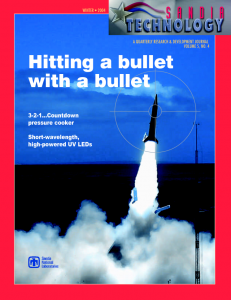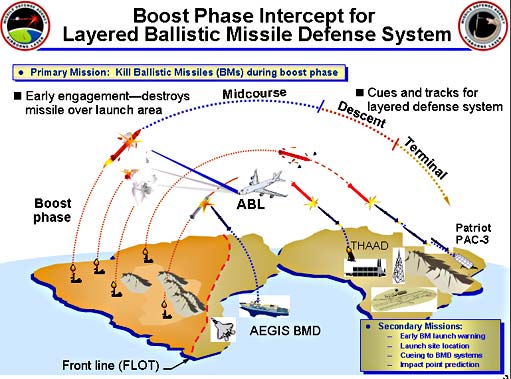The following is part of our series “Alternatives to the U.S. Navy’s DDG Flight III“
DDG-51 Flt III and the Shifting Sands of BMD Requirements
 To intercept a ballistic missile intercept, platforms must be at the right place at the right time to detect, track, and engage. Depending on the capability of the sensors and interceptors, these three locations may not be synonymous—the laws of physics and trigonometry are uncompromising; and, the clock is always ticking. Threats must be properly classified and their ultimate target determined. Flight paths and opportunities for intercept must be calculated. Interceptors must perform flawlessly, and to a degree, so must the adversary’s missile. Any deviation in expected performance throughout the boost, mid-course, and terminal phases that exceeds parameters might be enough to cause a failure to intercept.
To intercept a ballistic missile intercept, platforms must be at the right place at the right time to detect, track, and engage. Depending on the capability of the sensors and interceptors, these three locations may not be synonymous—the laws of physics and trigonometry are uncompromising; and, the clock is always ticking. Threats must be properly classified and their ultimate target determined. Flight paths and opportunities for intercept must be calculated. Interceptors must perform flawlessly, and to a degree, so must the adversary’s missile. Any deviation in expected performance throughout the boost, mid-course, and terminal phases that exceeds parameters might be enough to cause a failure to intercept.
Raytheon Missile Systems nonchalantly describes this manuever as “hitting a bullet with a bullet,” which still doesn’t quite respect enough the degree of complexity and luck required to conduct integrated air and missile defense (IAMD), the integration of simultaneous anti-air warfare (AAW) and ballistic missile defense (BMD). It does, however, hint at everything that is wrong with our approach to it. From largely ignoring cheaper ways to attack the enemy kill-chain to Aegis brand myopathy to shifting war-fighting capability requirements to fit fiscal/political constraints, the U.S. Navy is risking the credibility of its large cruiser/destroyer surface combatant force by building its justification on the shifting sands of its BMD requirements.
In 2007, the Navy completed its most aggressive, expensive ($35M) and comprehensive Analysis of Alternatives (AoA) to date, the Maritime Air and Missile Defense of Joint Forces (MAMDJF) AoA, also known as the Next-Generation Cruiser/“CG(X)” AoA. The recommendation of the analysis was for either a nuclear-powered cruiser or a conventionally powered cruiser with hybrid-electric drive/integrated propulsion system—both larger than the BB-41 Iowa-class battleships. These were to be capable of generating more wattage than the sum of the entire surface combatant fleet, and were to have radar array faces orders of magnitude larger and more sensitive than legacy SPY radars. The cost per hull was projected at a staggering $9B.
Among the alternatives the study looked at, near the rear of the discounted hull forms and behind a DDG-1000 mod, was a DDG-51 derivative. Yet in 2013, the 30-year shipbuilding plan shows 33 of these DDG-51 derivatives, now called Flt III! What changed that has made the alternative (and its 12-14 foot radar arrays) operationally acceptable when only CG(X) (and its 36 foot radar arrays) were acceptable in 2007-2010?
“I don’t believe they [CG(X) requirements] are clear. And I think its requirements at two levels. First we need to make sure we understand what it is we want on this ship and what it is we want in the fleet, how that is all going to work together. This ship is not going to work by itself. It’s going to work with other components, as part of ballistic missile defense system [and] many other components. We need to understand how that’s all going to work…. I think this is the first time in a long time that we’ve tried to work it in this formal a process. And to work through a real detailed specification and set of requirements. And that is creating some challenges. And there are tradeoffs that have to be done. And these are more than just worrying about what type of hull form we use…”
–Former SECNAV Donald Winter, 2007

From the January 2012 GAO report, “…since the MAMDJF AoA was released the Navy has changed its concept on numbers of Navy ships that will be operating in an IAMD environment.” This concept, “sensor-netting,” is not new and was in fact analyzed in the MAMDJF AoA, but the problem with relying on sensor-netting multiple sensors and shooters first observed then remains today. The capability to fuse multiple (and disparate) sensors and pass high-quality track data (measured by its track quality index (TQI)) in real-time for BMD does not exist, nor is there currently a plan to expand existing systems such as Cooperative Engagement Capability (CEC). If the Flight III CONOPS is therefore reliant upon satellite tactical data-links, what does it mean to the Navy’s BMD capability when confronted with an anti-access/area denial (A2AD) environment, such as we may face with a near-peer competitor? The GAO for one concluded that the Flight III will likely “be unsuitable for the most stressful threat environments it expects to face.”
The purpose of BMD is to defend the U.S. homeland, bases, critical infrastructure (including forces afloat), and Allies from ballistic missiles. All three of the defense departments—Army, Air Force, Navy—maintain a BMD capability. The Air Force and the Army have largely invested in developing capabilities to intercept ballistic missiles in terminal flight—their descent from space to final target. The Navy is primarily investing in interception at the boost and mid-course phases, due to Navy’s ability to use the ocean as maneuver space and close the threat, enhancing ballistic missile defense-in-depth while providing the only means of IAMD for the sea base.
Intercepting ballistic missiles in boost phase is the most dangerous as it requires the warship to be closest to the enemy. Intercepting in mid- course is the most difficult due to the distance, including the altitude, and window for intercept—taxing both radar and interceptors. In both phases, sufficient radar resources must be devoted to tracking the ballistic missile while still searching for additional ballistic or cruise missiles. For a DDG-51 Flight III without a large radar array, such as the one planned for CG(X), this will be much more challenging.

The Aegis combat system—a proprietary product of Lockheed Martin (LM)—has evolved from a robust anti-surface cruise missile (ASCM) area-defense system to a comprehensive combat system for all mission areas, including BMD. Attempts at forcing competition, open architecture, and migration to an enterprise-shared “Objective Architecture” starting with CG(X) have all ultimately failed as LM successfully lobbied against such efforts. While the merits of each position can be and often are debated, one fact remains: we are utilizing a combat management system that at its root was designed in the 1970s. Likewise, the decision to go with a Flt III of the DDG-51 line ensures that the Arleigh Burke-class (or derivatives thereof), will be in service for over 100 years. The B-52 and M-16 are the only likely other platforms that will be able to claim that dubious honor. How much capability can the Navy continue to squeeze out of a 40-year-old, proprietary combat system (despite its upgrades in hardware and software)? What is the return-on-investment? What changed since 2007 when PEO IWS determined that a new combat system was required for the IAMD mission?
Land targets must be defended by hard kill; attacking ballistic missiles with electronic warfare only to cause the missiles to later fall on civilian populations is unacceptable. Can the same thing be said about the sea base? Is there significant heartburn over a seduced, distracted, or diverted ballistic missile falling into unoccupied ocean, killing Flipper? The Navy should look beyond hard kill solutions for a better way to attack the kill chain that does not hazard surface combatants by closing the threat to achieve a boost-phase intercept, but also does not overly tax our radar and interceptor resources (and budgets) for a mid-course intercept. By focusing exclusively on hitting bullets with bullets; by reducing the IAMD requirements to fit the DDG rather than finding a ship that fits the requirements; and, by building its justification for the DDG line on the shifting sands of politically and fiscally constrained BMD requirements the Navy is risking the credibility and health of its surface force.
Nicolas di Leonardo is a member of the Expeditionary Warfare Division of the OPNAV staff and a graduate student of the Naval War College. The article represents the author’s views and is not necessarily the position of the Expeditionary Warfare Division, the Naval War College, or the United States Navy.

Excellent article. “Sensor netting” has been offered to offset the limitations of the 12-14 ft AMDR that can be accommodated on DDG 51 Flight III. With the termination of PTSS, a primary ballistic missile tracking sensor system, the success of a Navy ABM component would appear to be substantially more reliant on the larger AMDR solution in the MAMDJF AoA. It will be interesting to see if Navy can propose an objective solution, one that will work, for this critical national problem.
From all indications, the capability to fuse combat information from multiple force organic and external sensors in real-time in support of BMD and other warfare areas has not been fielded. This is more a reflection of Navy organizational seams and jealously guarded OPNAV and PEO IWS and PEO C4I territorial equities than a technical challenge. Requirements and resource sponsorship for “sensor netting”, the integration of ownforce and external combat information on combatants needs a single sponsor in OPNAV and a single PEO managing the acquisition.